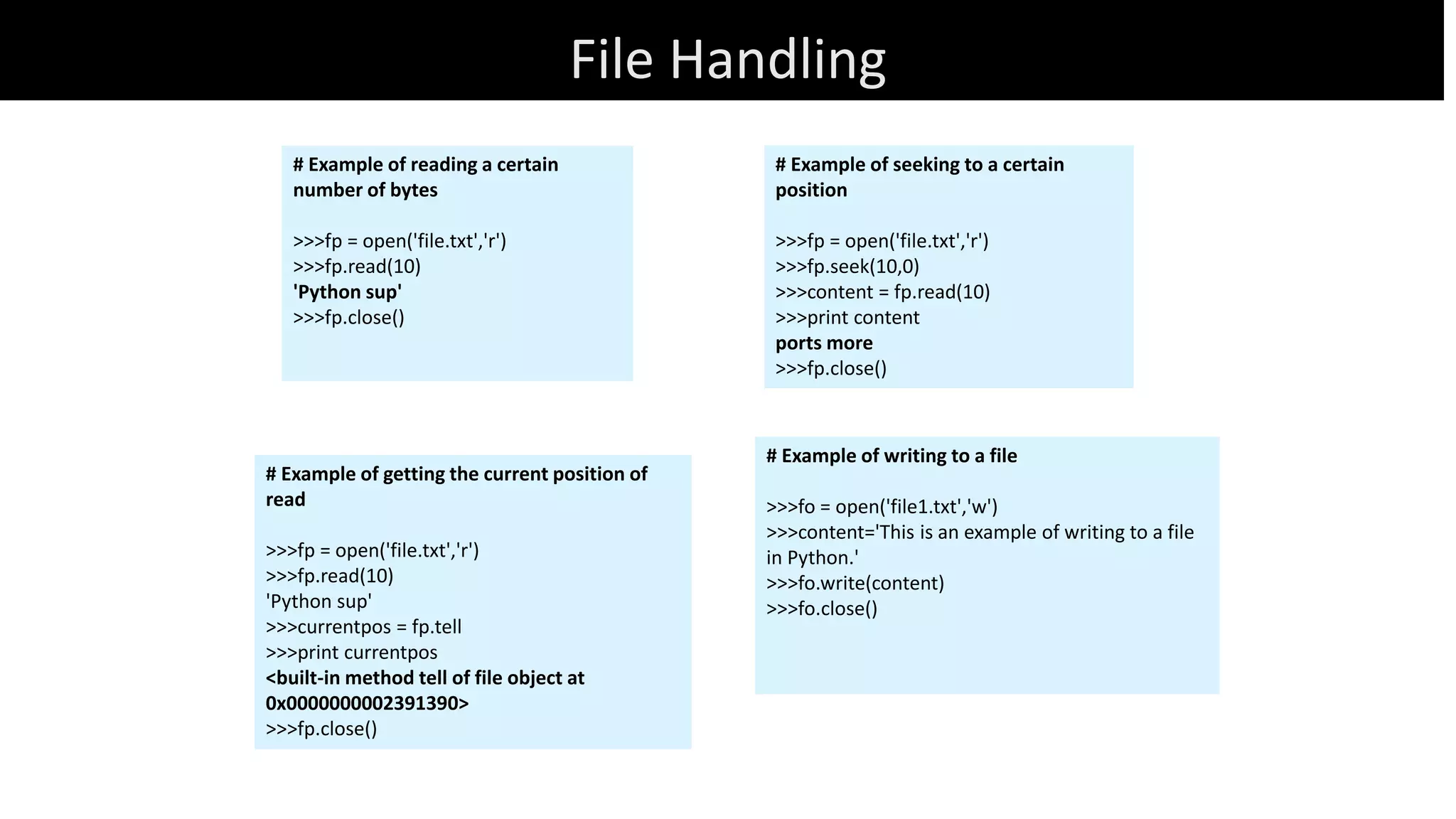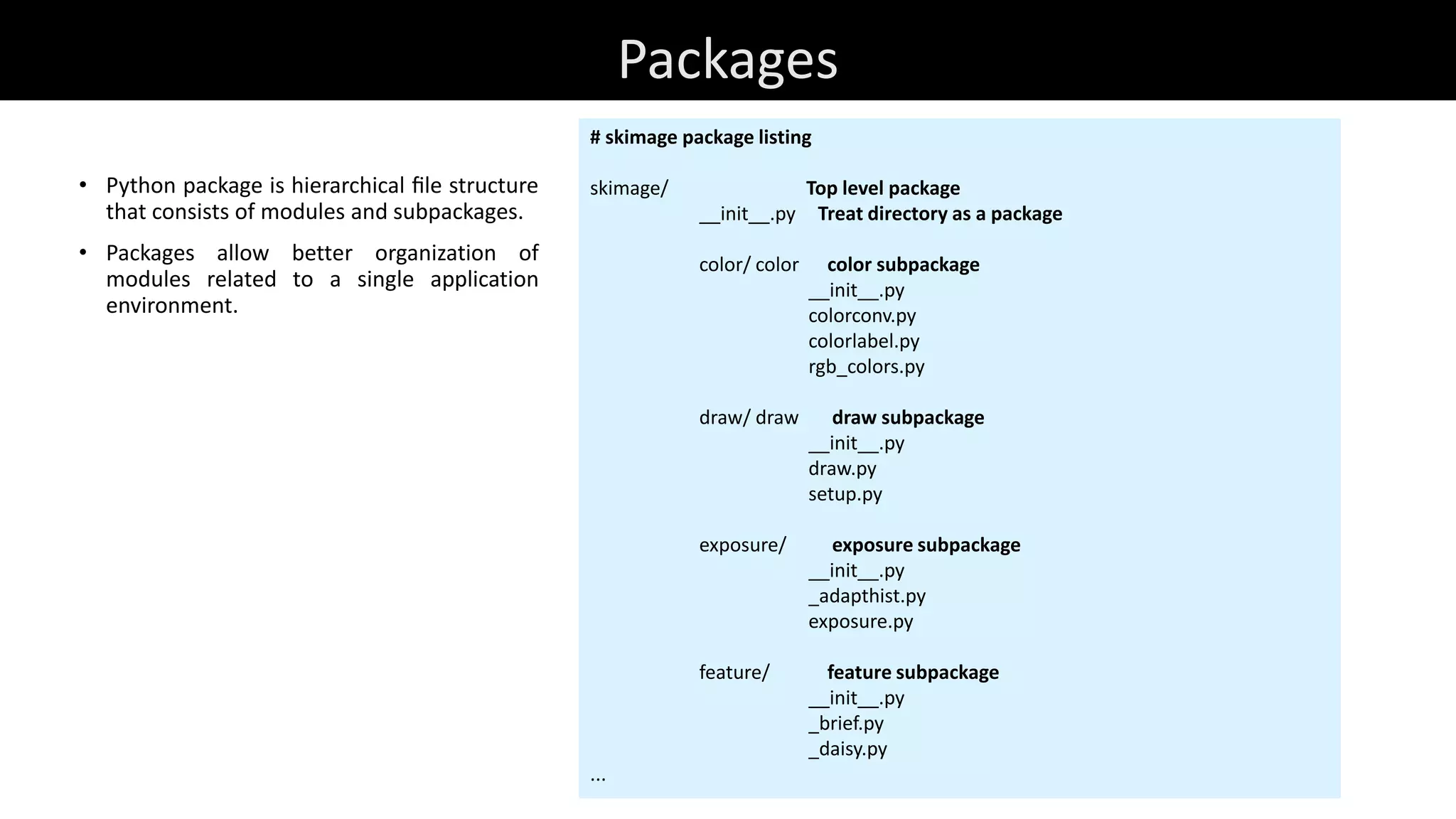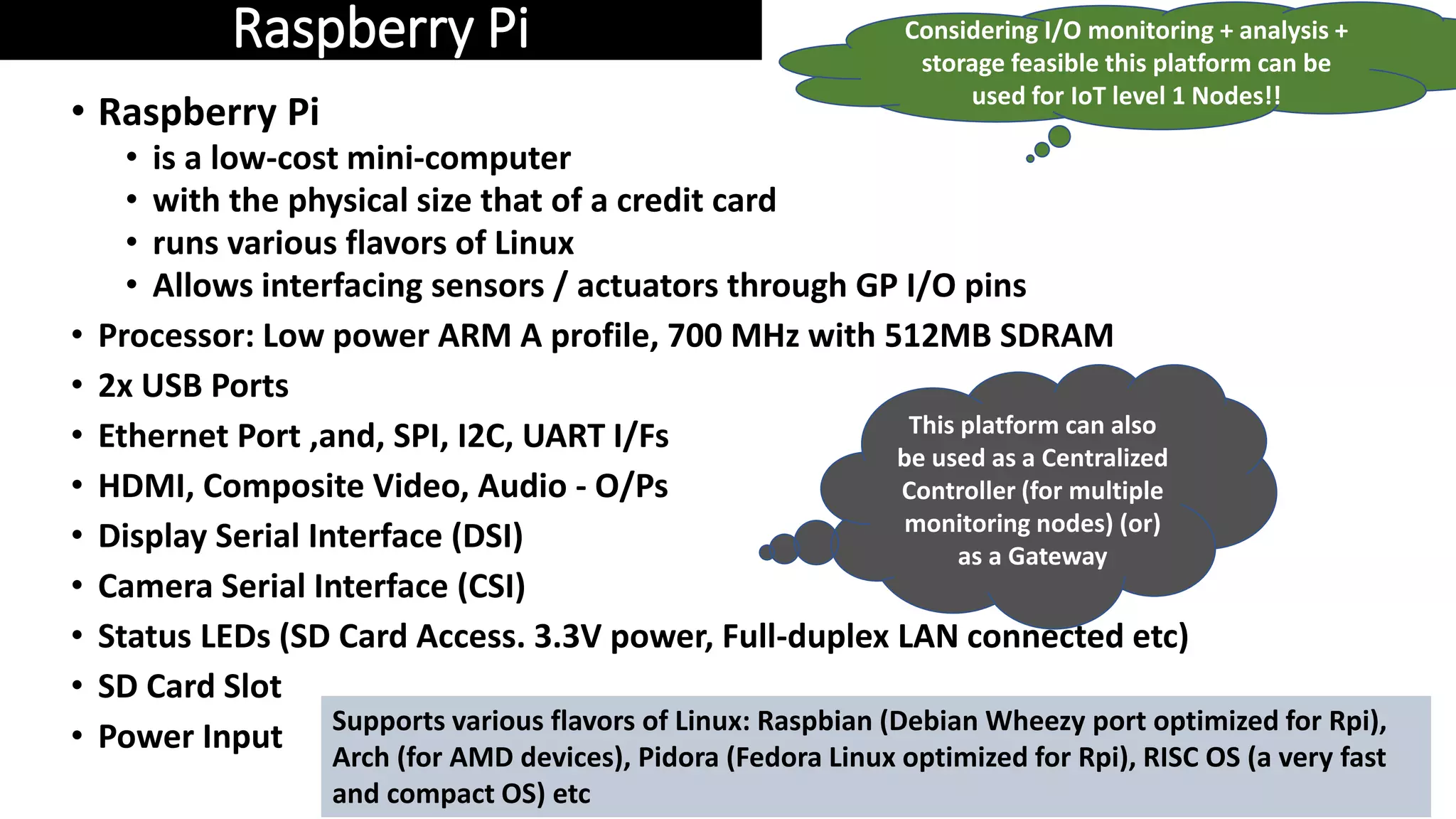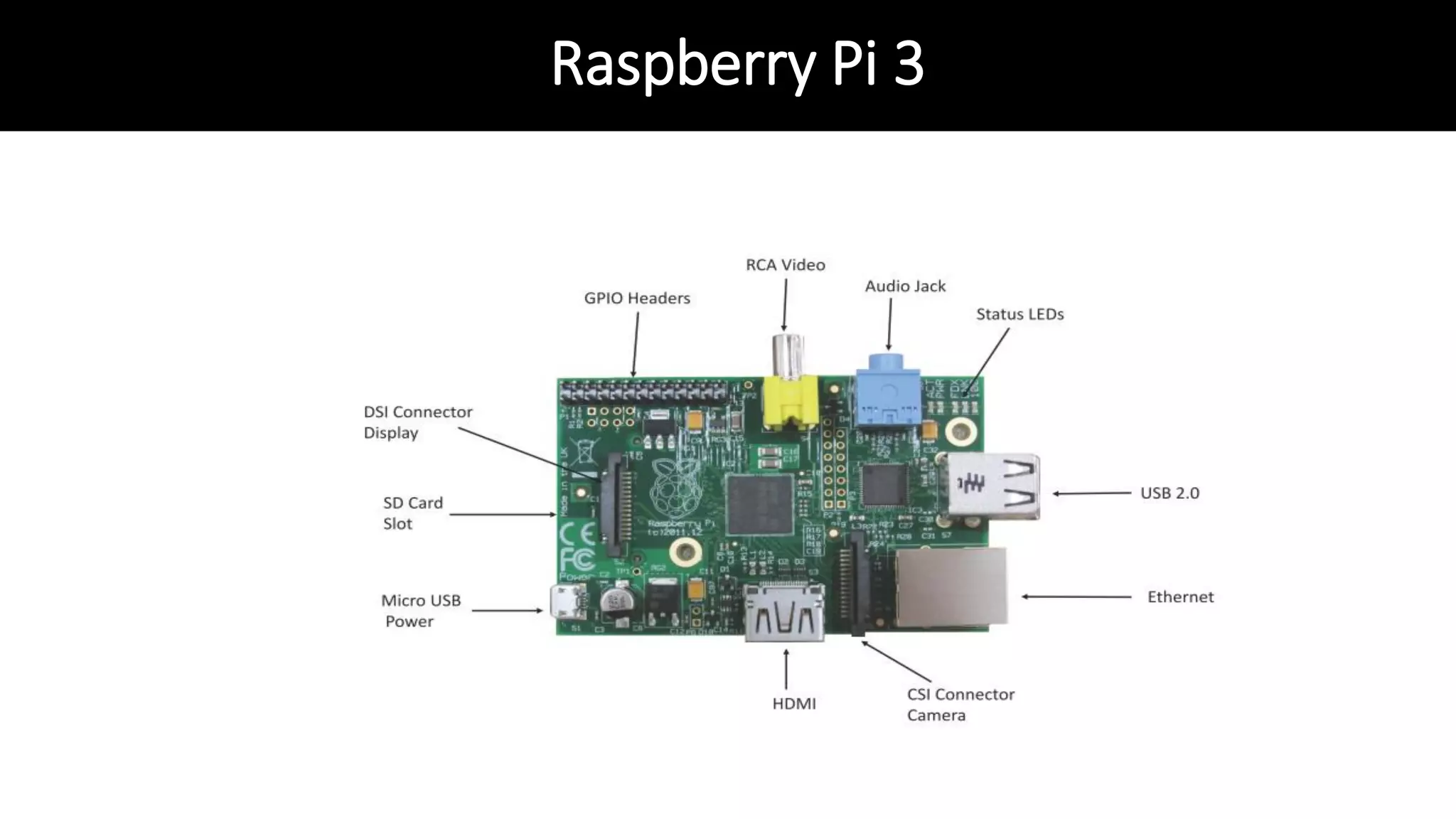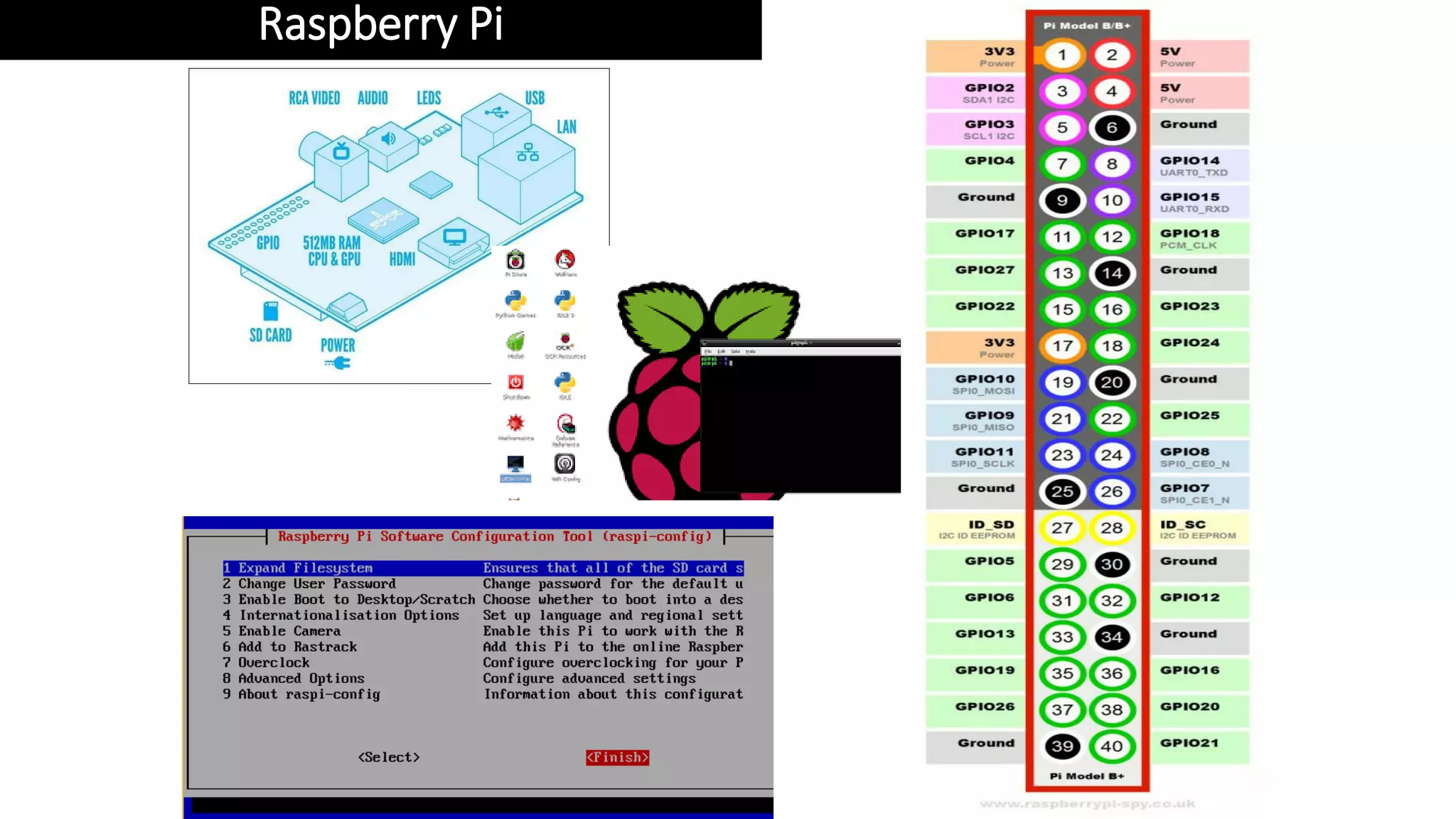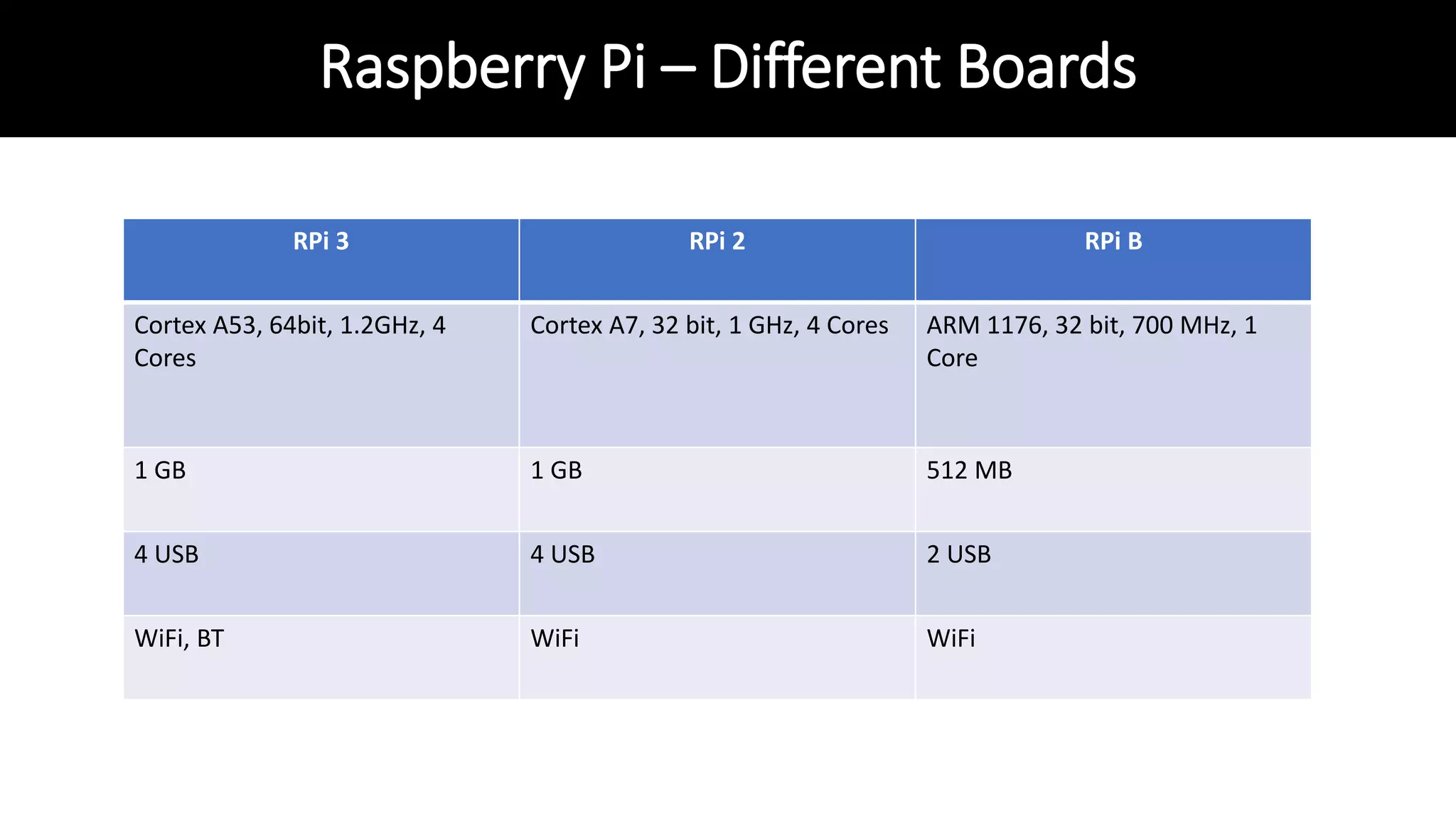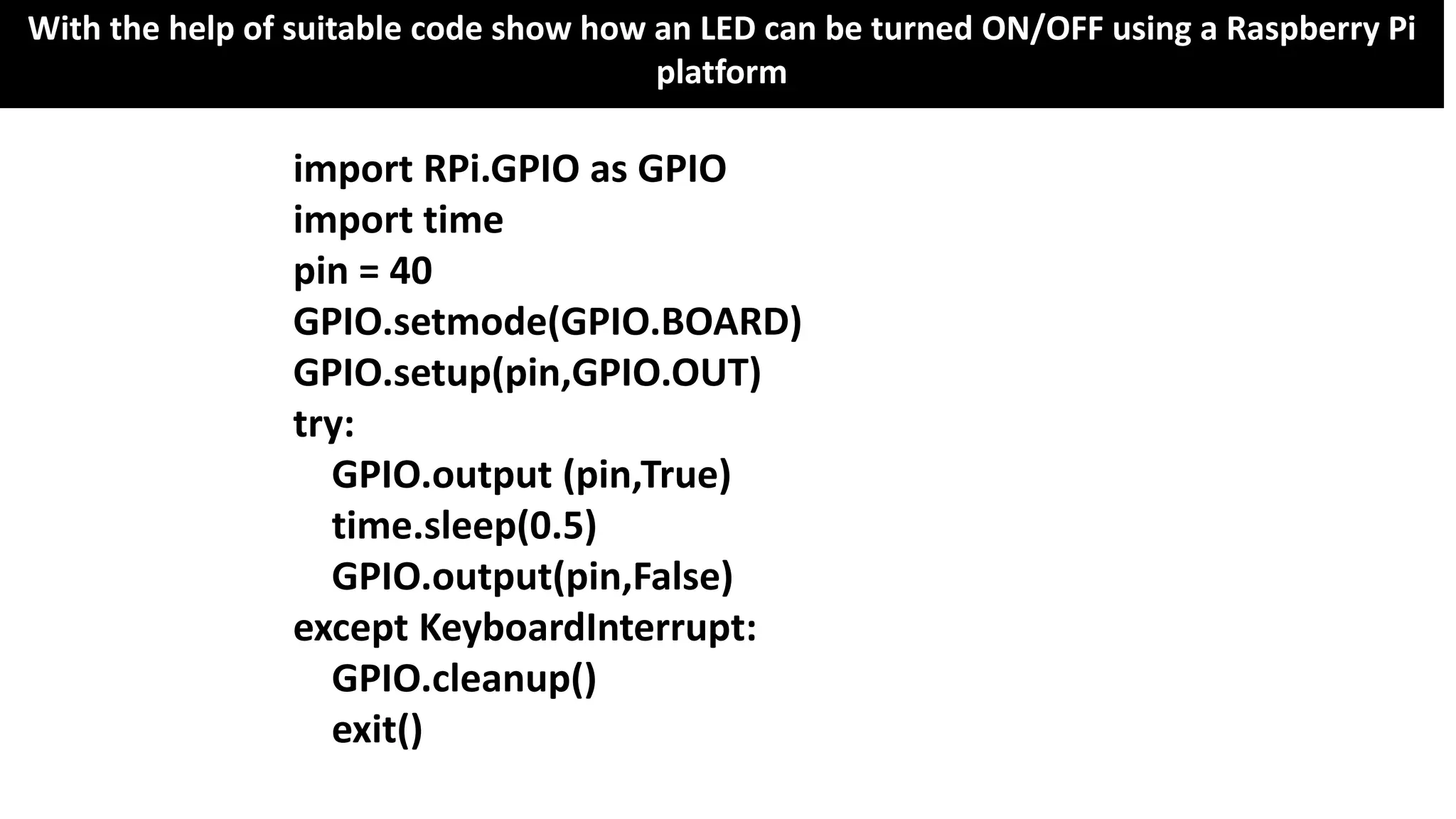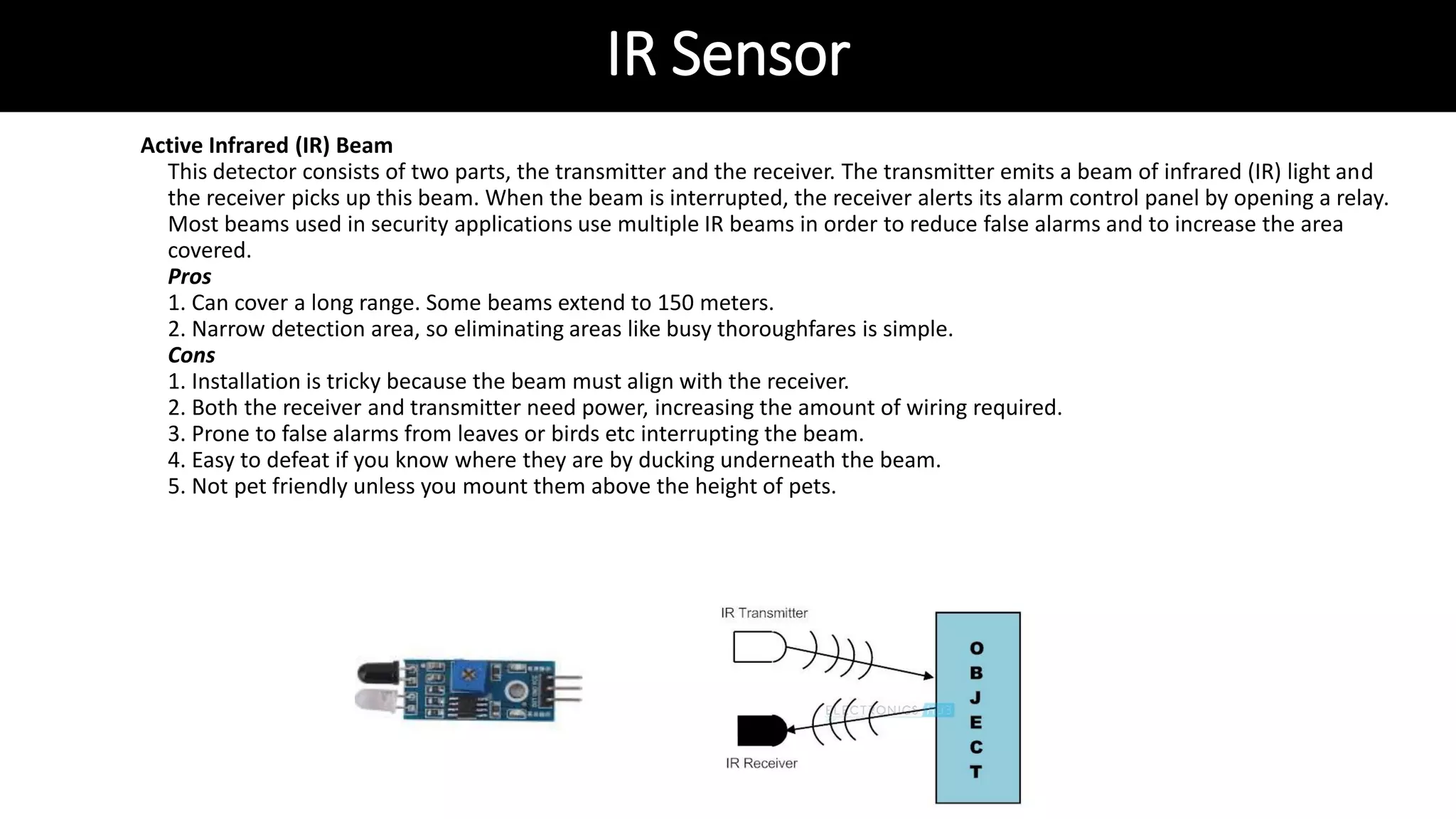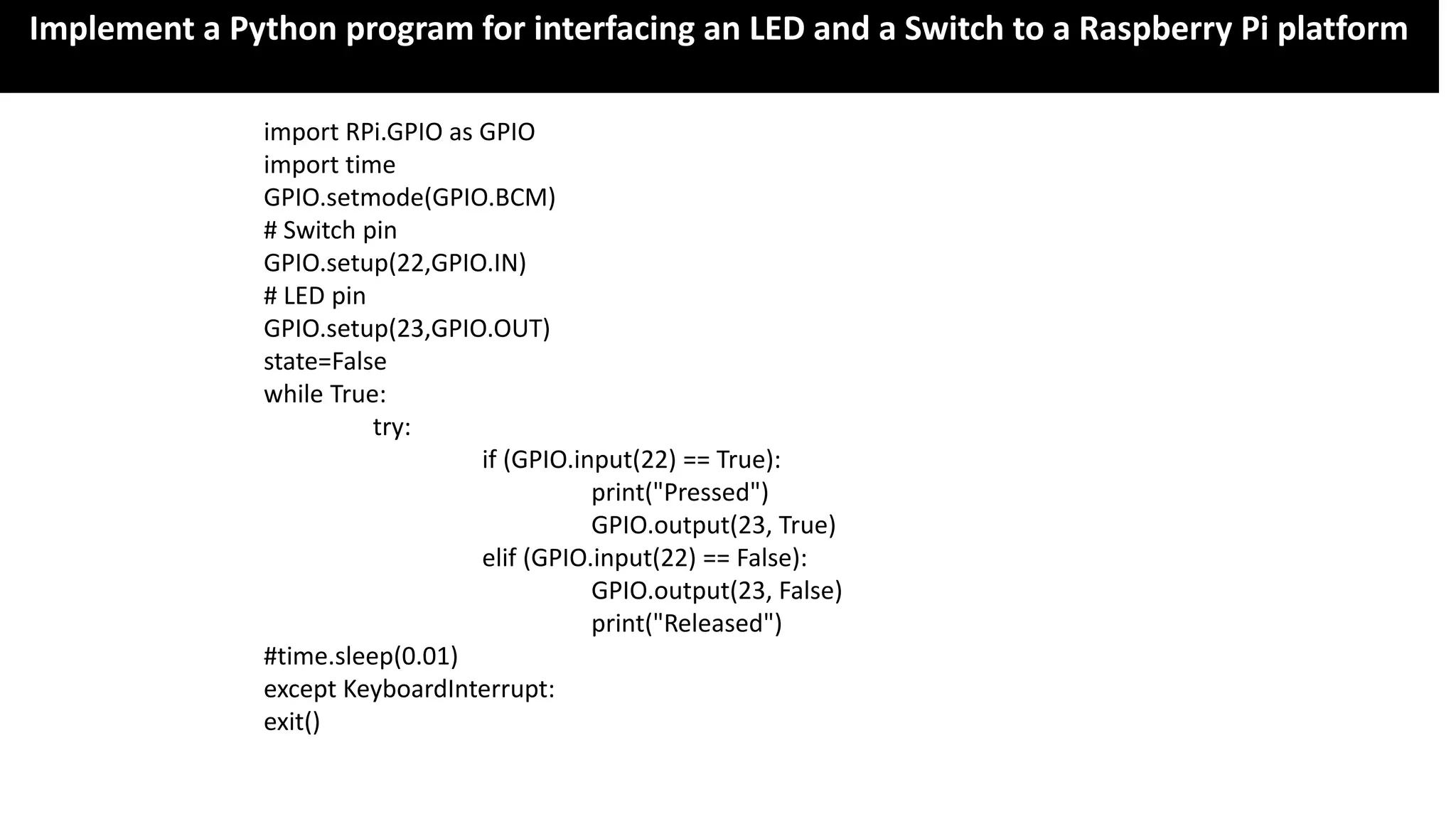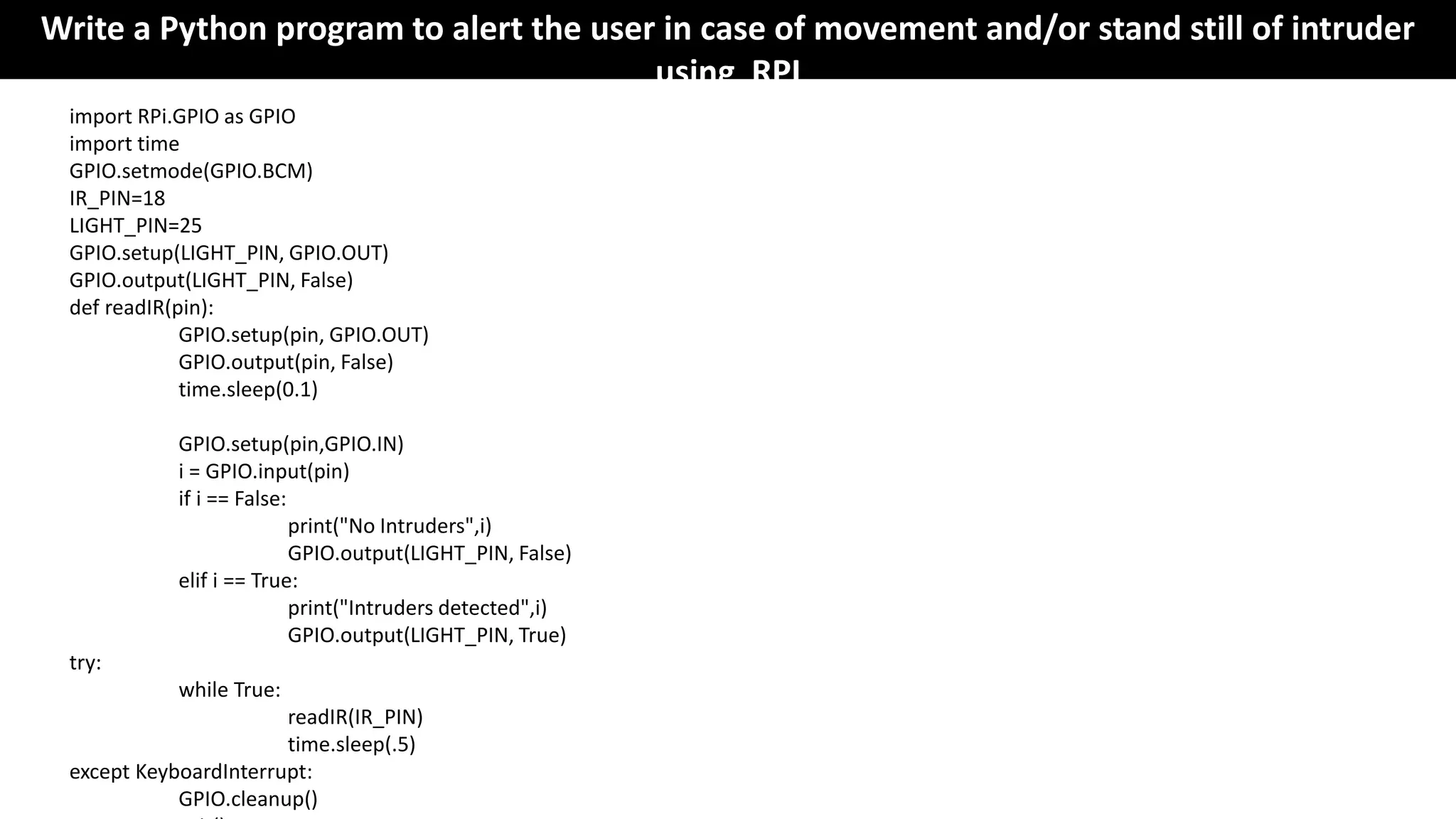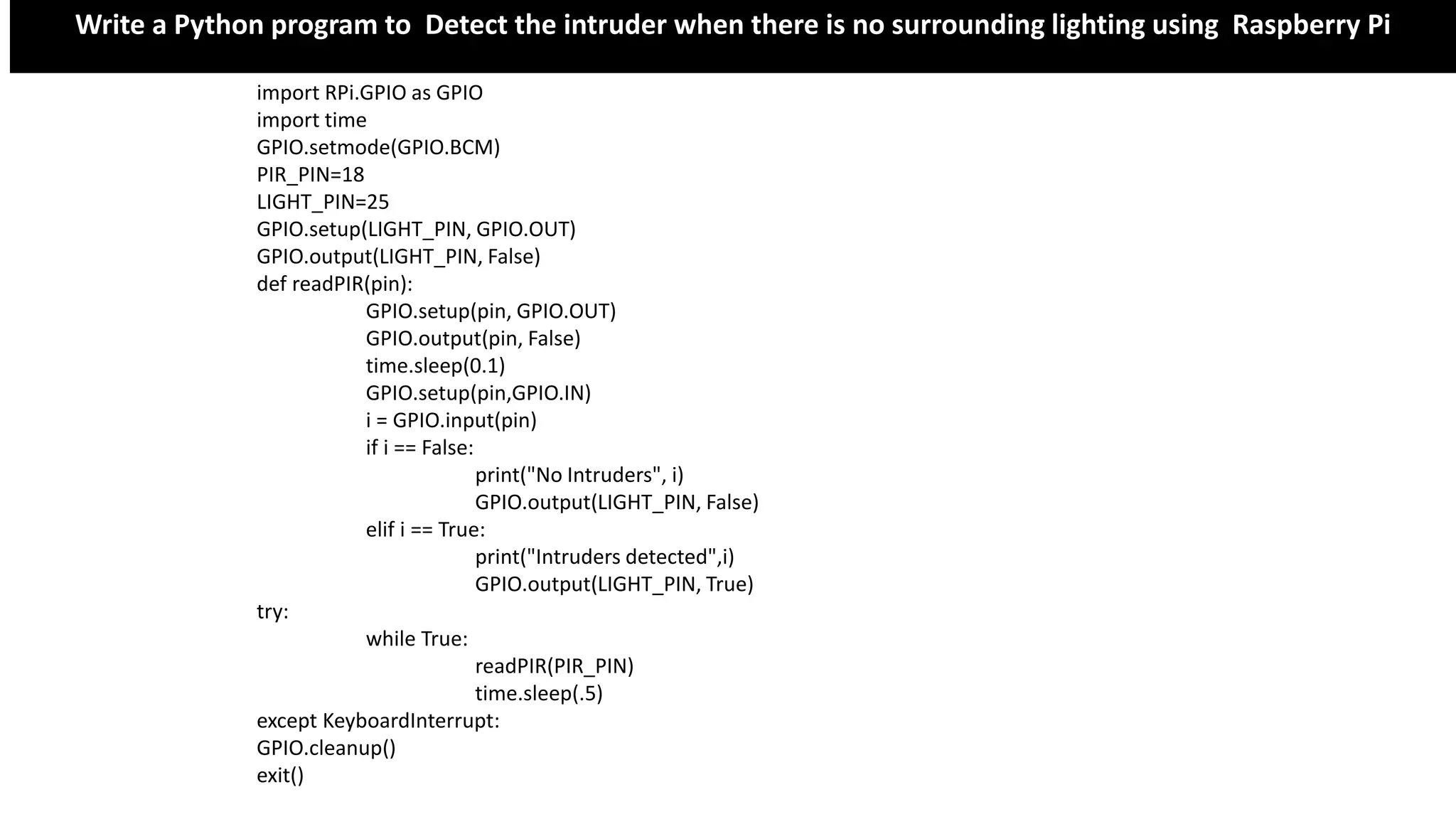This document provides an overview and agenda for a presentation on programming the Raspberry Pi (RPi) for Internet of Things (IoT) applications using Python. The agenda includes basics of Python, RPi basics, and RPi coding. Motivations for using Python with IoT systems are its intuitive syntax, portability, extensive library support, and ability to meet end-to-end development needs for tasks like capturing sensor data, web services, and analytics. Python code examples demonstrate numbers, strings, lists, tuples, dictionaries, and control flow statements. Setup instructions for Python on Windows and Linux are also included.



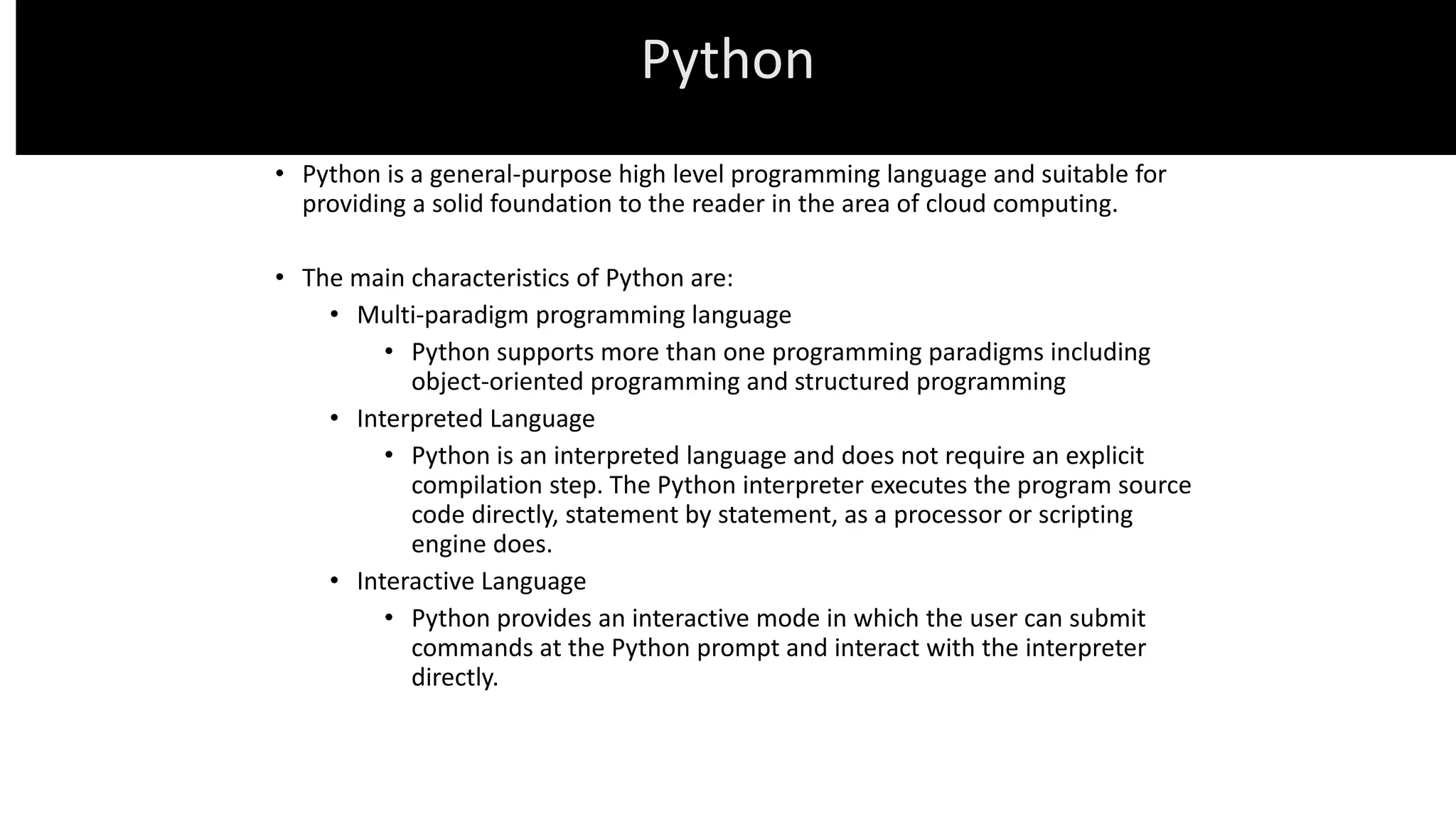
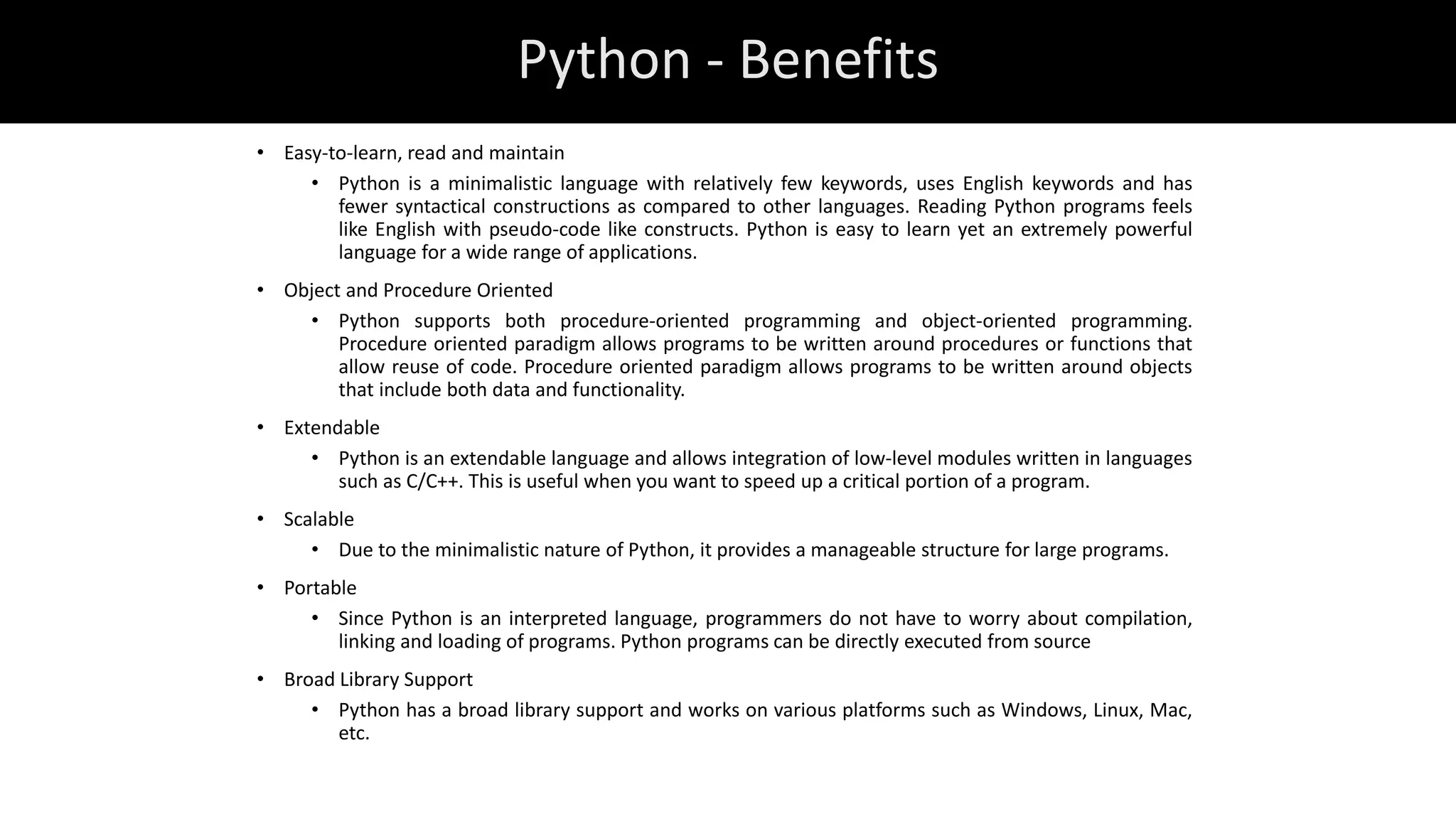

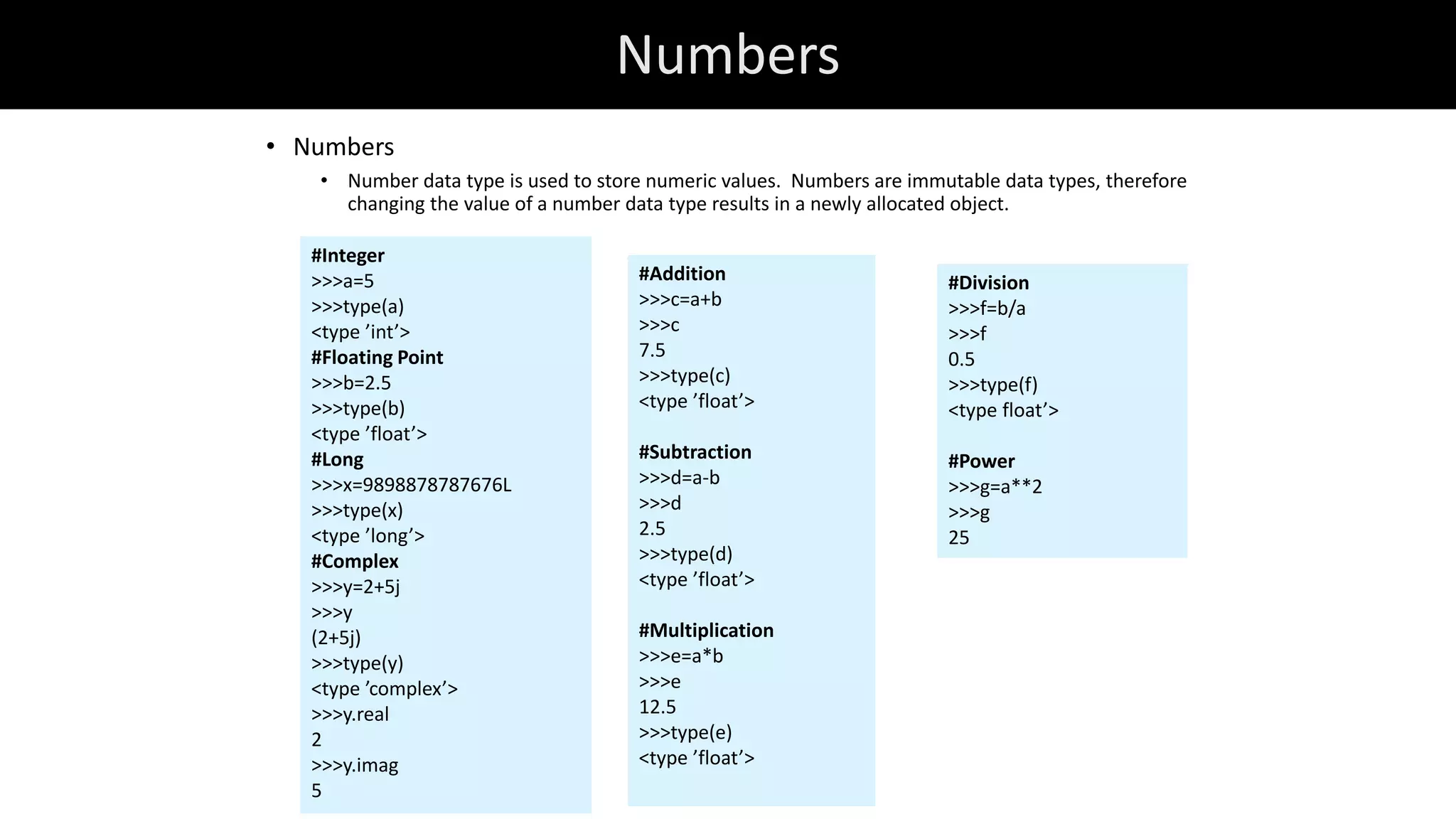
![Strings • Strings • A string is simply a list of characters in order. There are no limits to the number of characters you can have in a string. #Create string >>>s="Hello World!" >>>type(s) <type ’str’> #String concatenation >>>t="This is sample program." >>>r = s+t >>>r ’Hello World!This is sample program.’ #Get length of string >>>len(s) 12 #Convert string to integer >>>x="100" >>>type(s) <type ’str’> >>>y=int(x) >>>y 100 #Print string >>>print s Hello World! #Formatting output >>>print "The string (The string (Hello World!) has 12 characters #Convert to upper/lower case >>>s.upper() ’HELLO WORLD!’ >>>s.lower() ’hello world!’ #Accessing sub-strings >>>s[0] ’H’ >>>s[6:] ’World!’ >>>s[6:-1] ’World’ #strip: Returns a copy of the string with the #leading and trailing characters removed. >>>s.strip("!") ’Hello World’](https://image.slidesharecdn.com/programmingrpiforiotapplications-230418094749-d82f26cc/75/Programming-RPi-for-IoT-Applications-pdf-8-2048.jpg)
![Lists • Lists • List a compound data type used to group together other values. List items need not all have the same type. A list contains items separated by commas and enclosed within square brackets. #Create List >>>fruits=[’apple’,’orange’,’ba nana’,’mango’] >>>type(fruits) <type ’list’> #Get Length of List >>>len(fruits) 4 #Access List Elements >>>fruits[1] ’orange’ >>>fruits[1:3] [’orange’, ’banana’] >>>fruits[1:] [’orange’, ’banana’, ’mango’] #Appending an item to a list >>>fruits.append(’pear’) >>>fruits [’apple’, ’orange’, ’banana’, ’mango’, ’pear’] #Removing an item from a list >>>fruits.remove(’mango’) >>>fruits [’apple’, ’orange’, ’banana’, ’pear’] #Inserting an item to a list >>>fruits.insert(1,’mango’) >>>fruits [’apple’, ’mango’, ’orange’, ’banana’, ’pear’] #Combining lists >>>vegetables=[’potato’,’carrot’,’ onion’,’beans’,’radish’] >>>vegetables [’potato’, ’carrot’, ’onion’, ’beans’, ’radish’] >>>eatables=fruits+vegetables >>>eatables [’apple’, ’mango’, ’orange’, ’banana’, ’pear’, ’potato’, ’carrot’, ’onion’, ’beans’, ’radish’] #Mixed data types in a list >>>mixed=[’data’,5,100.1,8287398L] >>>type(mixed) <type ’list’> >>>type(mixed[0]) <type ’str’> >>>type(mixed[1]) <type ’int’> >>>type(mixed[2]) <type ’float’> >>>type(mixed[3]) <type ’long’> #Change individual elements of a list >>>mixed[0]=mixed[0]+" items" >>>mixed[1]=mixed[1]+1 >>>mixed[2]=mixed[2]+0.05 >>>mixed [’data items’, 6, 100.14999999999999, 8287398L] #Lists can be nested >>>nested=[fruits,vegetables] >>>nested [[’apple’, ’mango’, ’orange’, ’banana’, ’pear’], [’potato’, ’carrot’, ’onion’, ’beans’, ’radish’]]](https://image.slidesharecdn.com/programmingrpiforiotapplications-230418094749-d82f26cc/75/Programming-RPi-for-IoT-Applications-pdf-9-2048.jpg)
![Tuples • A tuple is a sequence data type that is similar to the list. A tuple consists of a number of values separated by commas and enclosed within parentheses. Unlike lists, the elements of tuples cannot be changed, so tuples can be thought of as read-only lists. #Create a Tuple >>>fruits=("apple","mango","banana", "pineapple") >>>fruits (’apple’, ’mango’, ’banana’, ’pineapple’) >>>type(fruits) <type ’tuple’> #Get length of tuple >>>len(fruits) 4 #Get an element from a tuple >>>fruits[0] ’apple’ >>>fruits[:2] (’apple’, ’mango’) #Combining tuples >>>vegetables=(’potato’,’carrot’,’onion’,’radis h’) >>>eatables=fruits+vegetables >>>eatables (’apple’, ’mango’, ’banana’, ’pineapple’, ’potato’, ’carrot’, ’onion’, ’radish’)](https://image.slidesharecdn.com/programmingrpiforiotapplications-230418094749-d82f26cc/75/Programming-RPi-for-IoT-Applications-pdf-10-2048.jpg)
![Dictionaries • Dictionaries • Dictionary is a mapping data type or a kind of hash table that maps keys to values. Keys in a dictionary can be of any data type, though numbers and strings are commonly used for keys. Values in a dictionary can be any data type or object. #Create a dictionary >>>student={’name’:’Mary’,’id’:’8776’,’major’:’CS’ } >>>student {’major’: ’CS’, ’name’: ’Mary’, ’id’: ’8776’} >>>type(student) <type ’dict’> #Get length of a dictionary >>>len(student) 3 #Get the value of a key in dictionary >>>student[’name’] ’Mary’ #Get all items in a dictionary >>>student.items() [(’gender’, ’female’), (’major’, ’CS’), (’name’, ’Mary’), (’id’, ’8776’)] #Get all keys in a dictionary >>>student.keys() [’gender’, ’major’, ’name’, ’id’] #Get all values in a dictionary >>>student.values() [’female’, ’CS’, ’Mary’, ’8776’] #Add new key-value pair >>>student[’gender’]=’female’ >>>student {’gender’: ’female’, ’major’: ’CS’, ’name’: ’Mary’, ’id’: ’8776’} #A value in a dictionary can be another dictionary >>>student1={’name’:’David’,’id’:’9876’,’major’:’ECE’} >>>students={’1’: student,’2’:student1} >>>students {’1’: {’gender’: ’female’, ’major’: ’CS’, ’name’: ’Mary’, ’id’: ’8776’}, ’2’: {’ major’: ’ECE’, ’name’: ’David’, ’id’: ’9876’}} #Check if dictionary has a key >>>student.has_key(’name’) True >>>student.has_key(’grade’) False](https://image.slidesharecdn.com/programmingrpiforiotapplications-230418094749-d82f26cc/75/Programming-RPi-for-IoT-Applications-pdf-11-2048.jpg)
![Type Conversions #Convert to string >>>a=10000 >>>str(a) ’10000’ #Convert to int >>>b="2013" >>>int(b) 2013 #Convert to float >>>float(b) 2013.0 #Convert to long >>>long(b) 2013L #Convert to list >>>s="aeiou" >>>list(s) [’a’, ’e’, ’i’, ’o’, ’u’] #Convert to set >>>x=[’mango’,’apple’,’banana’,’mango’,’banana’] >>>set(x) set([’mango’, ’apple’, ’banana’]) • Type conversion examples](https://image.slidesharecdn.com/programmingrpiforiotapplications-230418094749-d82f26cc/75/Programming-RPi-for-IoT-Applications-pdf-12-2048.jpg)
![Control Flow – if statement • The if statement in Python is similar to the if statement in other languages. >>>a = 25**5 >>>if a>10000: print "More" else: print "Less" More >>>s="Hello World" >>>if "World" in s: s=s+"!" print s Hello World! >>>if a>10000: if a<1000000: print "Between 10k and 100k" else: print "More than 100k" elif a==10000: print "Equal to 10k" else: print "Less than 10k" More than 100k >>>student={’name’:’Mary’,’id’:’8776’} >>>if not student.has_key(’major’): student[’major’]=’CS’ >>>student {’major’: ’CS’, ’name’: ’Mary’, ’id’: ’8776’}](https://image.slidesharecdn.com/programmingrpiforiotapplications-230418094749-d82f26cc/75/Programming-RPi-for-IoT-Applications-pdf-13-2048.jpg)
![Control Flow – for statement • The for statement in Python iterates over items of any sequence (list, string, etc.) in the order in which they appear in the sequence. • This behavior is different from the for statement in other languages such as C in which an initialization, incrementing and stopping criteria are provided. #Looping over characters in a string helloString = "Hello World" for c in helloString: print c #Looping over keys in a dictionary student = ’name’: ’Mary’, ’id’: ’8776’,’gender’: ’female’, ’major’: ’CS’ for key in student: print "%s: %s" % (key,student[key] #Looping over items in a list fruits=[’apple’,’orange’,’banana’,’mango’] i=0 for item in fruits: print "Fruit-%d: %s" % (i,item) i=i+1](https://image.slidesharecdn.com/programmingrpiforiotapplications-230418094749-d82f26cc/75/Programming-RPi-for-IoT-Applications-pdf-14-2048.jpg)
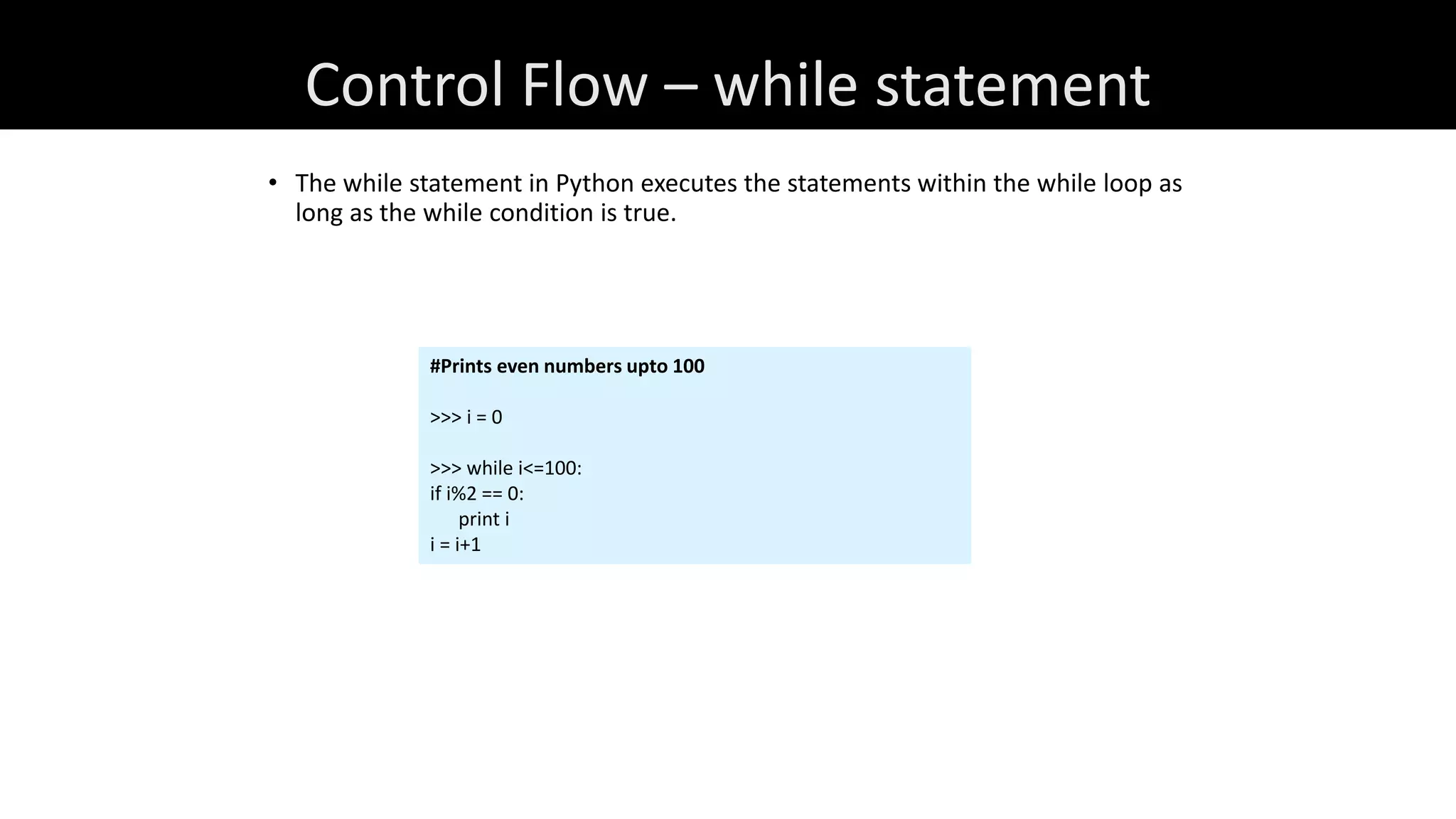
![Control Flow – Range statement • The range statement in Python generates a list of numbers in arithmetic progression. #Generate a list of numbers from 10 - 100 with increments of 10 >>>range(10,110,10) [10, 20, 30, 40, 50, 60, 70, 80, 90,100] #Generate a list of numbers from 0 – 9 >>>range (10) [0, 1, 2, 3, 4, 5, 6, 7, 8, 9]](https://image.slidesharecdn.com/programmingrpiforiotapplications-230418094749-d82f26cc/75/Programming-RPi-for-IoT-Applications-pdf-16-2048.jpg)
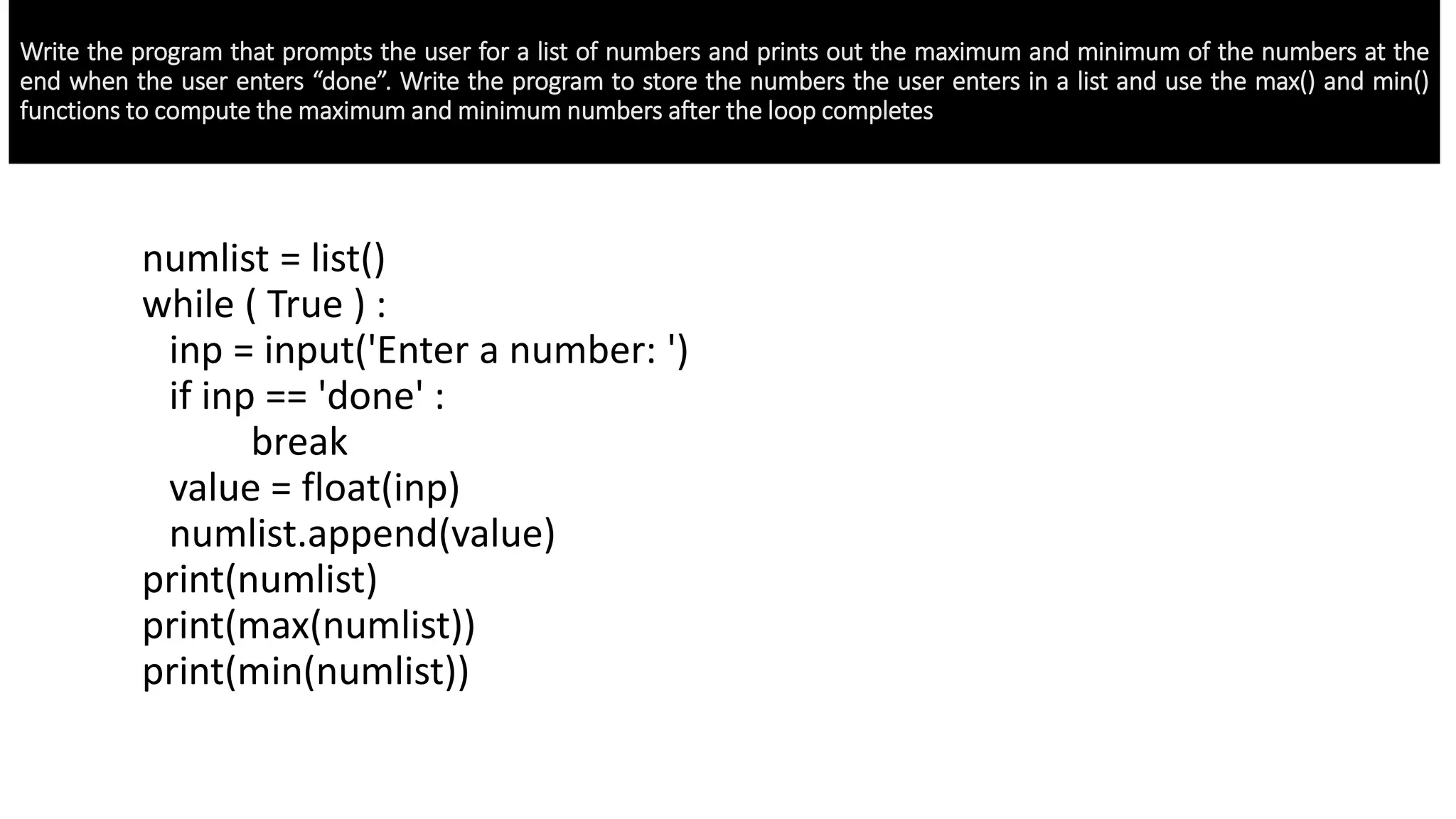
![Functions • A function is a block of code that takes information in (in the form of parameters), does some computation, and returns a new piece of information based on the parameter information. • A function in Python is a block of code that begins with the keyword def followed by the function name and parentheses. The function parameters are enclosed within the parenthesis. • The code block within a function begins after a colon that comes after the parenthesis enclosing the parameters. • The first statement of the function body can optionally be a documentation string or docstring. students = { '1': {'name': 'Bob', 'grade': 2.5}, '2': {'name': 'Mary', 'grade': 3.5}, '3': {'name': 'David', 'grade': 4.2}, '4': {'name': 'John', 'grade': 4.1}, '5': {'name': 'Alex', 'grade': 3.8}} def averageGrade(students): ‘’’This function computes the average grade’’’ sum = 0.0 for key in students: sum = sum + students[key]['grade'] average = sum/len(students) return average avg = averageGrade(students) print ("The average garde is: %0.2f" % (avg)) Syntax def functionname( parameters ): “’function_docstring“’ function_suite return [expression]](https://image.slidesharecdn.com/programmingrpiforiotapplications-230418094749-d82f26cc/75/Programming-RPi-for-IoT-Applications-pdf-18-2048.jpg)
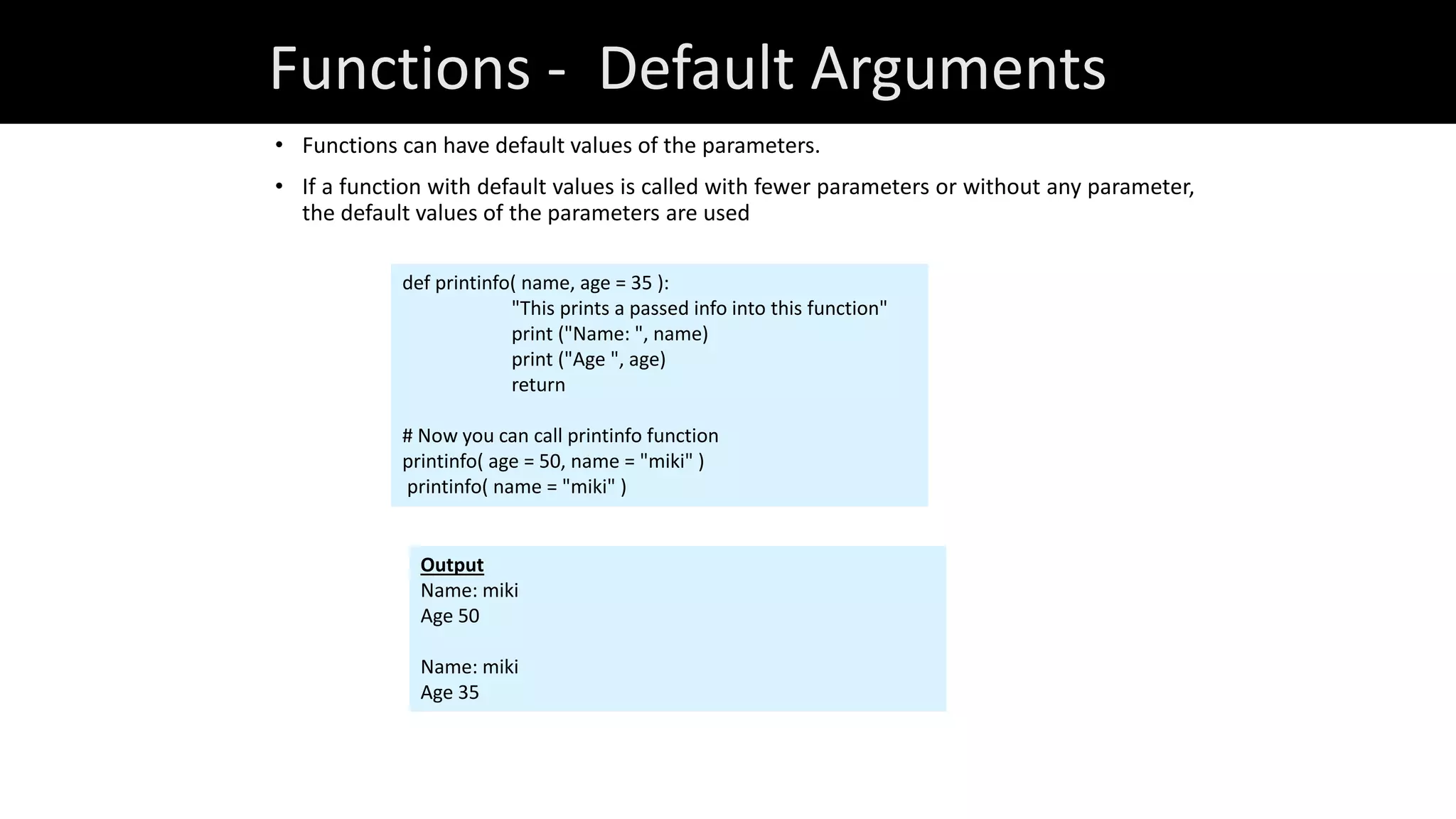
![Functions - Passing by Reference • All parameters in the Python functions are passed by reference. • If a parameter is changed within a function the change also reflected back in the calling function. # Function definition is here def changeme( mylist ): "This changes a passed list into this function" print ("Values inside the function before change: ", mylist) mylist[2]=50 print ("Values inside the function after change: ", mylist) return # Now you can call changeme function mylist = [10,20,30] changeme( mylist ) print ("Values outside the function: ", mylist) Output Values inside the function before change: [10, 20, 30] Values inside the function after change: [10, 20, 50] Values outside the function: [10, 20, 50]](https://image.slidesharecdn.com/programmingrpiforiotapplications-230418094749-d82f26cc/75/Programming-RPi-for-IoT-Applications-pdf-20-2048.jpg)
![Functions - Passing by Reference # Function definition is here def changeme( mylist ): "This changes a passed list into this function" mylist = [1,2,3,4] # This would assi new reference in mylist print ("Values inside the function: ", mylist) return # Now you can call changeme function mylist = [10,20,30] changeme( mylist ) print ("Values outside the function: ", mylist) Output Values inside the function: [1, 2, 3, 4] Values outside the function: [10, 20, 30]](https://image.slidesharecdn.com/programmingrpiforiotapplications-230418094749-d82f26cc/75/Programming-RPi-for-IoT-Applications-pdf-21-2048.jpg)
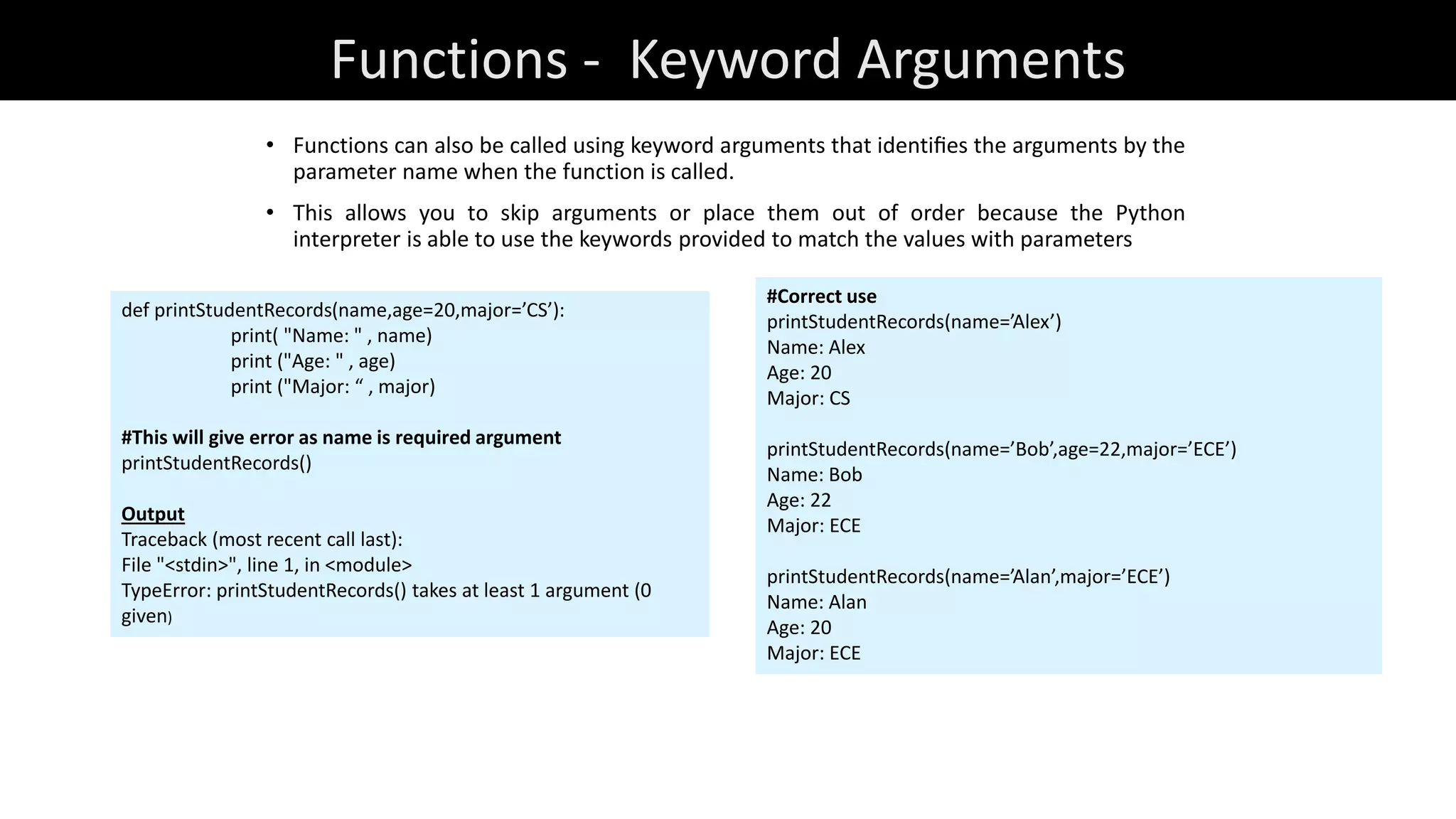
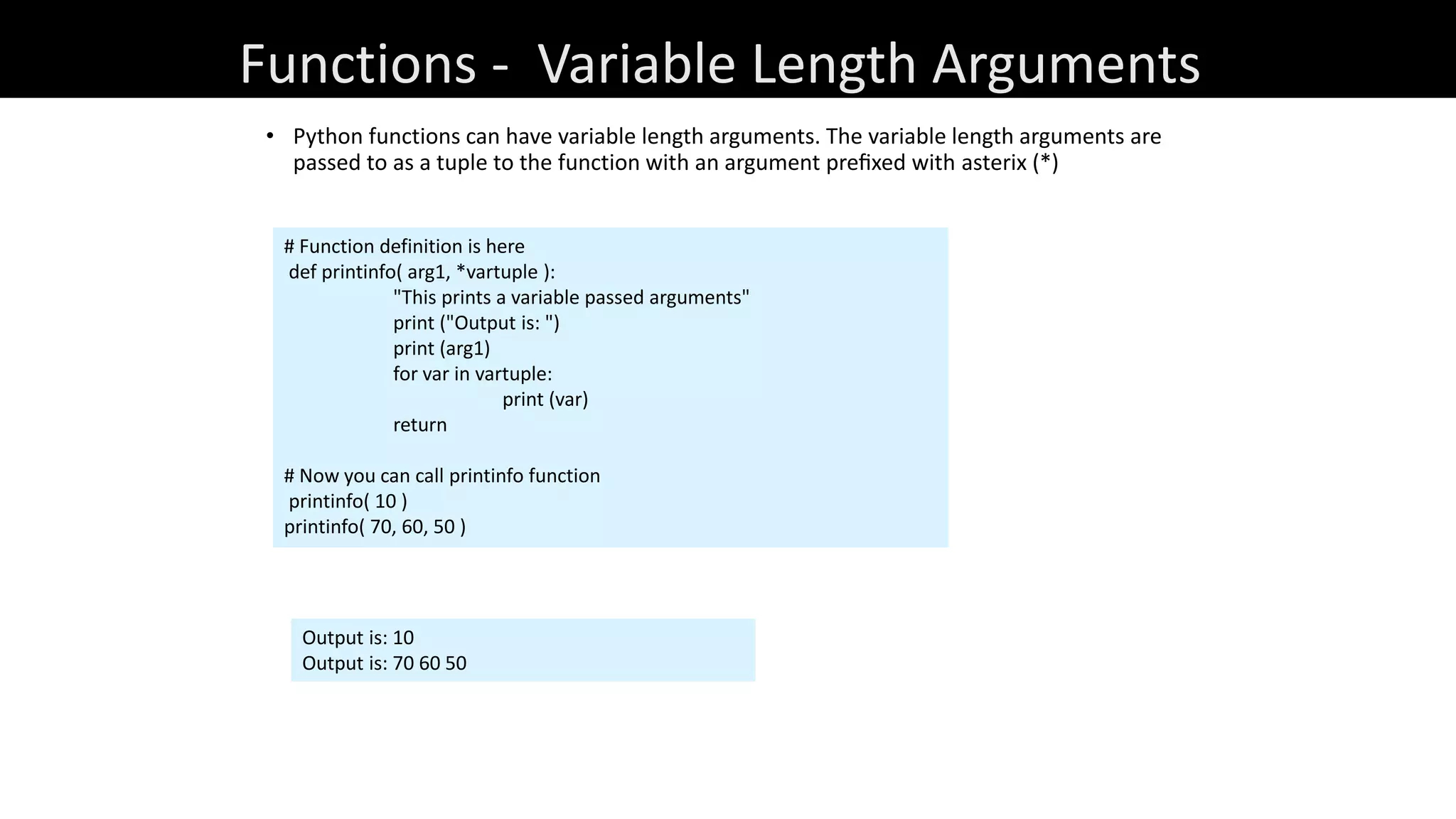
![Modules • Python allows organizing the program code into different modules which improves the code readability and management. • A module is a Python file that defines some functionality in the form of functions or classes. • Modules can be imported using the import keyword. • Modules to be imported must be present in the search path. #student module - saved as student.py def averageGrade(students): sum = 0.0 for key in students: sum = sum + students[key]['grade'] average = sum/len(students) return average def printRecords(students): Print( "There are %d students“ %(len(students))) i=1 for key in students: print( "Student-%d: " % (i)) print ("Name: " ,students[key]['name']) print "Grade: " ,str(students[key]['grade']) i = i+1 #Using student module >>>import student >>>students = '1': 'name': 'Bob', 'grade': 2.5, '2': 'name': 'Mary', 'grade': 3.5, '3': 'name': 'David', 'grade': 4.2, '4': 'name': 'John', 'grade': 4.1, '5': 'name': 'Alex', 'grade': 3.8 >>>student.printRecords(students) There are 5 students Student-1: Name: Bob Grade: 2.5 Student-2: Name: David Grade: 4.2 Student-3: Name: Mary Grade: 3.5 Student-4: Name: Alex Grade: 3.8 Student-5: Name: John Grade: 4.1 >>>avg = student. averageGrade(students) >>>print ("The average garde is: %0.2f" % (avg)) 3.62 # Importing a specific function from a module >>>from student import averageGrade # Listing all names defines in a module >>>dir(student)](https://image.slidesharecdn.com/programmingrpiforiotapplications-230418094749-d82f26cc/75/Programming-RPi-for-IoT-Applications-pdf-24-2048.jpg)
![File Handling • Python allows reading and writing to files using the file object. • The open(filename, mode) function is used to get a file object. • The mode can be read (r), write (w), append (a), read and write (r+ or w+), read-binary (rb), write-binary (wb), etc. • If the buffering value is set to 0, no buffering takes place. If the buffering value is 1, line buffering is performed while accessing a file. If you specify the buffering value as an integer greater than 1, then buffering action is performed with the indicated buffer size • After the file contents have been read the close function is called which closes the file object. # Example of reading line by line >>>fp = open('file1.txt','r') >>>print( "Line-1: " , fp.readline()) Line-1: Python supports more than one programming paradigms. >>>print ("Line-2: " , fp.readline()) Line-2: Python is an interpreted language. >>>fp.close() # Example of reading an entire file >>>fp = open('file.txt','r') >>>content = fp.read() >>>print content This is a test file. >>>fp.close() # Example of reading lines in a loop >>>fp = open(’file1.txt’,’r’) >>>lines = fp.readlines() >>>for line in lines: print( line) Python supports more than one programming paradigms. Python is an interpreted language. # Syntax for opening a file file object = open(file_name [, access_mode][, buffering])](https://image.slidesharecdn.com/programmingrpiforiotapplications-230418094749-d82f26cc/75/Programming-RPi-for-IoT-Applications-pdf-25-2048.jpg)
